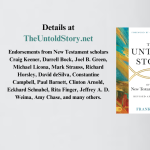Anti-moderns often speak nostalgically of the “crowded universe” of yesterday, when the world wasn’t just matter in motion but full of fairies and sprites and whatnot. It’s a charming picture, but the reality of a crowded universe wasn’t necessarily a happy thing. Stephan Maul writes of ancient Mesopotamia: “If a dog constantly howled and yelped in someone’s house, this boded evil for the owner of the house and his family. The person affected, however, had more to fear than impending doom,... Read more
















